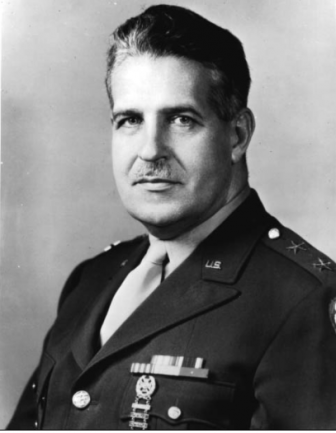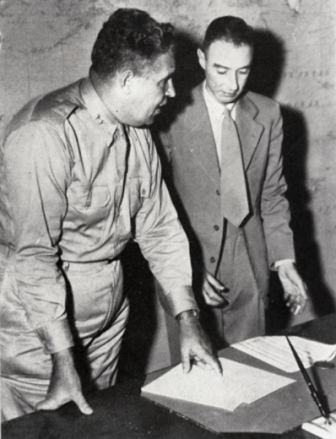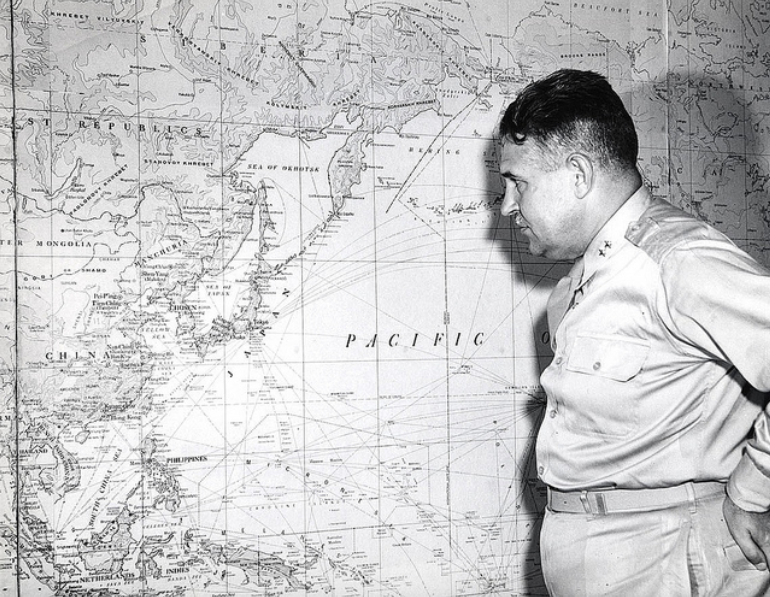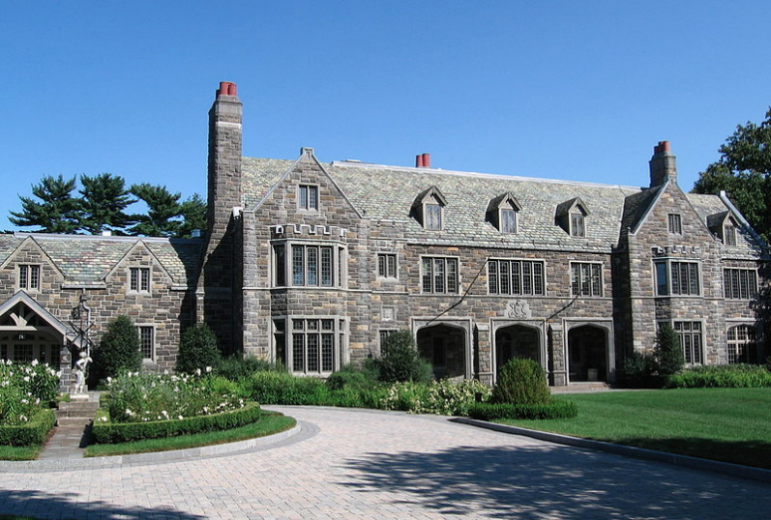After Albert Einstein convinced President Franklin Roosevelt that an atomic bomb could and should be built during World War II, the government turned to Gen. Leslie Groves, a brash, brusque and brilliant army officer to get it done.
He succeeded in organizing and administering the project that built the two deadliest weapons ever used by mankind, resulting in the atomic attacks on Hiroshima and Nagasaki. But the same personality and tactics that helped him burst through bureaucratic obstacles to get the job done during the war proved fatal to his own post-war career in the Army. After Dwight Eisenhower gave him the results of a devastating job evaluation, Groves was out the door in February 1948.
That’s when he took a job heading up research for one of the earliest computer companies, Remington Rand, and bought a newly built house that still stands today at 9 Dellwood Road in Darien, a short commute to the site of his research division in Rowayton. (Several years later, after Gen. Douglas MacArthur was cashiered by President Harry Truman, that general also worked at the Rowayton office.)

U.S. government photo
Gen. Leslie R. Groves Jr.
By 1955, Groves (then 59 years old) was a vice president for Remington Rand “working on policy matters,” according to a March 31 report in the Darien Review.
“He likes to play tennis, go to football games and, much against his will (that I did not write, he did) does certain chores around the house and grounds,” interviewer Beatrice Colgate wrote in her article.
The son of an army chaplain, Leslie R. Groves Jr. was born in 1896 in Albany, New York and his childhood was spent moving with his family from army base to army base. He went to West Point, where he graduated fourth in his class and became an army engineer.
In 1931, he was in Nicaragua as part of a survey team looking into whether another canal could be built between the Atlantic and Pacific oceans when an earthquake hit. He was put in charge of Managua’s water supply system, earning him a medal from that nation’s president.
As World War II loomed, the draft was restarted, massive amounts of weapons were ordered and the military was expanded. An old friend of Groves’ became quartermaster general of the army and got Groves transferred to be his assistant. Groves traveled around the country inspecting the expansion projects for military camps and facilities. A December 1940 Life magazine article on 90 leaders in the war mobilization effort included Groves.
In 1941, Groves was put in charge of monitoring military construction across the country. By August, that included overseeing the construction of the Pentagon, planned as the largest office building in the world, with 5.1 million square feet of space. Each of the five sides (or wings) of the building was built in succession, with personnel moving in to work as the rest of the project was completed.
Groves and officials working under him were told to get the project done fast, and Groves was put in control of it. Despite strikes and shortages of material, the project was completed months early, in January 1943.
By then, Groves had been tapped for the Manhattan Project. He had been hoping for a fighting command in the war, but was told by a superior officer that his request was being rejected, In his 1962 book about the Manhattan Project, “Now It Can Be Told,” Groves recounted receiving the news outside a congressional hearing room, just after he’d testified:
“The secretary of war has selected you for a very important assignment, and the President has approved it,” Lt. Gen. Brehon Somervell told Groves. “If you do the job right, it will win the war.”
Groves wrote: “My initial reaction was one of extreme disappointment.” For one thing, he wrote, the budget was far less than the nationwide construction budget he was already working with.
Later that morning, Somervell’s chief of staff, Wilhelm Styer, told Groves more about the job: “The basic research and development are done. You just have to take the rough designs, put them into proper shape, build some plants and organize an operating force and your job will be finished and the war will be over.”
Groves recalled: “Naturally, I was skeptical, but it took me several weeks to realize just how overoptimistic an outlook he had presented.” As Groves suggested, he was left in charge of the Pentagon project until its completion, partly to help keep his role in the Manhattan Project quiet for a while longer. He also asked to be promoted to general as a way of helping to get the new project done.
Like the construction of the Pentagon and many other efforts at the time, the massive engineering project needed to be done quickly — in time to beat the equivalent Nazi effort.
At some point during the project it became clear that it would be much more expensive than the $100 million initially planned (the cost eventually rose to $2 billion), Groves wrote. Everything touching on it, from aspects of international relations to the advancement of science, had to be subordinated to getting bombs ready as fast as possible.
“Not until later would all concerned grow accustomed to the idea that, while normally haste makes waste, in this case haste was essential,” Groves wrote. It turned out that the scientific research wasn’t nearly as “done” as the chief of staff had suggested.

U.S. government photo
Leslie Groves with Robert Oppenheimer, whom he chose to run the scientific research at Los Alamos, New Mexico
Groves picked Robert J. Oppenheimer to oversee the scientific research for the project at Los Alamos. Despite the scientist’s associations with communists in the recent past, Groves pushed for him to be hired, saying that Oppenheimer could keep secrets and was the best man for the job.
In directing the project, Groves signed off on locating various facilities around the country, including Oak Ridge, Tennessee; Los Alamos, New Mexico; and Hannaford, Washington.
“Wearing civilian clothes, he criss‐crossed the country, per suading such industrial giants as E. I. dupont de Nemours & Co. to take an active part in the production of fissionable materials. Hundreds of private contractors were intimately involved in the secret project,” Groves’ New York Times obituary said.
“General Groves watched over the details of securing and processing the radium and other materials used in the bombs, and he supervised development of the devices that carried the nuclear loads and triggered them over Hiroshima and Nagasaki, Japan,” according to the obituary.
By 1945, 600,000 civilians and military personnel were working on the Manhattan Project, the Times obituary said.
“For three critical years,” said Glenn Seaborg, chairman of the Atomic Energy Commission, said at the time of Groves’ death, “he directed the most awesome project in the history of mankind. He was a constant source of amazement . . . He had the deep respect and admiration of his staff for his ability to organize and get things done.”
After meeting with Groves, Vannevar Bush, one of the key people who created the Manhattan Project before Groves became involved, wrote after meeting with him that “having seen General Groves briefly, I doubted whether he had sufficient tact for such a job. […] Styer [the chief of staff] agreed the man is blunt, etc., but thought his other qualities would overbalance.” Groves and Bush later became friends.
Again and again people who worked with Groves and described him would mention his ability to get things done (and as fast as possible) along with his stepping on toes along the way.
_____________________
Sources for this article:
—Robert S. Norris, “Racing for the Bomb” 2002
—Leslie Groves, “Now It Can Be Told,” 1962 (parts of it on Google Books, here)
—Beatrice Colgate, “Our Interesting Neighbors,” 52 articles based on interviews with Darienites, reprinted from the Darien Review, 1954-1957 (Darien Library has a copy of the book, which can also be found on eBay)
—”Gen. Groves of Manhattan Project Dies,” obituary, New York Times, July 15, 1970
—”The Computer Age Began in a Barn,” New York Times, March 29, 1998
—”If You Build It,” review of “Racing for the Bomb,” June 30, 2002
_____________________
When Kenneth Nichols, an army officer who worked closely under Groves (both in Nicaragua and in the Manhattan Project), gave this plainspoken description of him, Nichols covered both the positive and negative — including some aspects that could be both at once:
“First, General Groves is the biggest S.O.B. I have ever worked for. He is most demanding. He is most critical. He is always a driver, never a praiser. He is abrasive and sarcastic. He disregards all normal organizational channels. He is extremely intelligent. He has the guts to make difficult, timely decisions. He is the most egotistical man I know. He knows he is right and so sticks by his decision. He abounds with energy and expects everyone to work as hard or even harder than he does. Although he gave me great responsibility and adequate authority to carry out his mission-type orders, he constantly meddled with my subordinates. However, to compensate for that he had a small staff, which meant that we were not subject to the usual staff-type heckling. He ruthlessly protected the overall project from other government agency interference, which made my task easier. He seldom accepted other agency cooperation and then only on his own terms. During the war and since I have had the opportunity to meet many of our most outstanding leaders in the Army, Navy and Air Force as well as many of our outstanding scientific, engineering and industrial leaders. And in summary, if I had to do my part of the atomic bomb project over again and had the privilege of picking my boss I would pick General Groves.”

Photo from National Archives
Leslie Groves at his desk, 1945
Robert S. Norris, in his biography of Groves, “Racing for the Bomb,” said of him: “No one can ever remember hearing him swear. Neither did he erupt in volcanic outbursts or routinely dress down subordinates. His mere presence was normally enough to deliver the message loud and clear. Those who entered his orbit could feel the emanations that declared, in no uncertain terms, that you had better do your job, do it well, and do it on time.”
When Churchill asked that Groves travel to Britain to brief the prime minister on the progress of the Manhattan Project, the U.S. Secretary of War, Henry Stimson, told Groves he couldn’t go due to safety considerations. Groves pointed out that Stimson and Gen. George Marshall traveled in unsafe conditions. Stimson replied. “You can’t be replaced, and we can.” Stimson ordered Groves to hire someone who might replace him, if necessary.
Just before President Roosevelt left for the Yalta summit, Groves told him he believed that by August the Manhattan Project would be ready with two bombs, which should be sufficient to end the war. The first was dropped on Hiroshima on Aug. 6, the second on Nagasaki on Aug. 9.
Between 129,000 and 226,000 people, mostly civilians, died in the bombings, the only times nuclear weapons have been used in war. Historians, agreeing with President Harry Truman, who made the final decision to drop the bombs, have said an invasion of Japan while refraining from using the atom bombs would have resulted in many more casualties, both Japanese and American, civilian and military.

U.S. government photo
Groves and his target
After the war, Dwight Eisenhower became the U.S. Army chief of staff. He met with Groves on Jan. 30, 1948, as part of a performance evaluation. Eisenhower told Groves about a long list of complaints from people who had worked with Groves, and Groves realized he’d never get the jobs he wanted in the army.
He submitted his resignation within a few days and got back in touch with Remington Rand, one of the companies who had made him a job offer in the past. (James Rand, its president, was a Darien resident.)
Groves, who had been in charge of billions of dollars in spending on federal projects, wasn’t poor, but he needed the income. While his wife was away on a trip to Mexico with friends, he visited the Dellwood Road house with his daughter (he also had a son in the Army Corps of Engineers) and bought it.

Photo from Wikimedia Commons
Rockledge mansion, Remington Rand corporate headquarters (2007 photo)
Just after the war, Remington Rand bought Rock Ledge, an estate in Rowayton. The company’s headquarters were moved into the estate’s mansion and, across the street, a stable was used for the research staff, which initially consisted of about nine employees. By 1950, the company had produced Univac, one of the first commercially available computers for businesses and government agencies.
Unlike the Manhattan Project, which Harry Truman hadn’t even been told about until he became president (and Groves’ own wife didn’t know about until the bombs were dropped), security was much more lax at Remington Rand, at least early on, when the stable door wasn’t even locked at the end of the day.

Photo from Wikimedia Commons
Between the time this building was a stable and when it began housing Rowayton Library, research that led to the Univac computer went on here.
On some mornings, employees would come in to find that the caretaker’s kids had been playing in the building, which is now Rowayton Library.
Later, when Douglas MacArthur was hired (he commuted up from Manhattan), MacArthur would stand near the entrance to the mansion starting at 8 a.m. and observe employees walking in. Eventually the staff got the point that they should be at the office that early.
Remington Rand was bought out by another company in 1955, and the new business was named Sperry Rand. That, in a later consolidation with other companies, became part of Unisys.
At the age of 65, Groves retired from Sperry Rand in 1961. He published his book on the Manhattan Project, “Now It Can Be Told,” early in 1962. He inscribed personalized copies of the book that were sent to Oppenheimer, Truman and Douglas MacArthur.
The New York Herald Tribune reviewer said of it: “We see this mammoth venture through the eyes of the tough, blunt bear of a man who was its top administrator […]”
A historian at Los Alamos wrote in Saturday Review: “Groves is motivated by a simple and all-sufficing patriotism that is untroubled by what others see in the atom. He does not probe for any new vision of national interest in the age he helped create.”
In 1964, he moved to the Washington, D.C. area. He passed away in 1970.
When Beatrice Colgate interviewed Groves for the Darien Review, she asked him how the Manhattan Project was kept so secret.
“If you have ever been the object of his direct look, you will know why I dropped my pencil in utter confusion when he said,
“‘Mainly by not talking to reporters.'”
“‘Poor me!’ said I, and we had a good laugh.”
